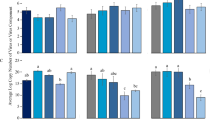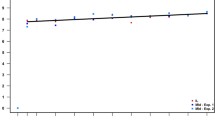Abstract
Relationships of an Italian isolate of tomato yellow leaf curl geminivirus from Sardinia (TYLCV-S) with its whitefly vectorBemisia tabaci were studied by means of experimental transmissions from tomato to tomato plants. TYLCV-S was confirmed to be transmitted in a persistent, circulative manner. The minimum latent period in the vector was between 17 and 20 h from the beginning of the acquisition access period (AAP). The maximum retention of infectivity was 8 days from the end of the AAP. Both acquisition and inoculation feeding times influenced the detected proportion of infective insects, with patterns well described by an exponential model. Acquisition was more efficient than inoculation. Males were significantly less efficient vectors than females. Nymphs were as efficient as adults in acquiring the virus. The length of AAP influenced both the retention of infectivity, and the pattern of transmission in serial transfer transmission tests with individual females. No significant difference in transmission efficiency was detected between two colonies ofB. tabaci, one inducing typical silverleaf symptoms on squash, the other inducing only mild symptoms with more than 50 whiteflies per plant. The phenomenon of periodic acquisition was not unequivocally proved for TYLCV-S.
Similar content being viewed by others
References
Cohen S, Duffus JE and Liu HY (1989) Acquisition, interference, and retention of cucurbit leaf curl viruses in whiteflies. Phytopathology 79: 109–113
Cohen S, Duffus JE and Liu HY (1992) A newBemisia tabaci biotype in the Southern United States and its role in silverleaf of squash and transmission of lettuce infectious yellows virus. Phytopathology 82: 86–90
Cohen S and Harpaz I (1964) Periodic, rather than continual acquisition of a new tomato virus by its vector, the tobacco whitefly (Bemisia tabaci Gennadius). Entomologia Experimentalis et Applicata 7: 155–166
Cohen S and Nitzani FE (1966) Transmission and host range of the tomato yellow leaf curl virus. Phytopathology 56: 1127–1131
Costa HS and Brown JK (1991) Variation in biological characteristics and esterase patterns among populations ofBemisia tabaci, and the association of one population with silverleaf symptom induction. Entomologia Experimentalis et Applicata 61: 211–219
Credi R, Betti L and Canova A (1989) Association of a geminivirus with a severe disease of tomato in Sicily. Phytopathologia Mediterranea 28: 223–226
Crespi S, Accotto GP, Caciagli P and Gronenborn B (1991) Use of digoxygenin-labelled probes for detection and hostrange studies of tomato yellow leaf curl geminivirus. Research in Virology 142: 283–288
Czosnek H, Ber R, Antignus Y, Cohen S, Navot N and Zamir D (1988) Isolation of tomato yellow leaf curl virus, a geminivirus. Phytopathology 78: 508–512
Czosnek H, Navot N and Laterrot H (1990) Geographical distribution of tomato yellow leaf curl virus. A first survey using a specific DNA probe. Phytopathologia Mediterranea 29: 1–6
Duffus JE (1987) Whitefly transmission of plant viruses. In: Harris KF (ed) Current topics in vector research vol 4 (pp. 73–91) Springer-Verlag, New York
Fleiss JL (1981) Statistical methods for rates and proportions, second edition. John Wiley & Sons, New York. xviii + 321 pp
Gallitelli D, Luisoni E, Martelli GP, Caciagli P, Milne RG, Accotto GP e Antignus Y (1991) L'accartocciamento fogliare giallo del pomodoro in Sardegna. Informatore Fitopatologico (7–8): 42–46
Getz WM, Sylvester ES and Richardson J (1982) Pea enation mosaic virus transmission by the pea aphid: a multiphase model of virus transmission. Phytopathology 72: 1145–1148
Gildow FE and Rochow WF (1981) Selectivity in transmission of plant pathogens by vectors: a luteovirus-aphid model. In: McKelvey JJ, Eldridge BF and Maramorosh K (eds) Vectors of disease agents—Interactions with plants, animals, and man (pp. 61–71) Praeger Publishers, New York
Kheyr-Pour A, Bendahmane M, Matzeit V, Accotto GP, Crespi S and Gronenborn B (1991) Tomato yellow leaf curl virus from Sardinia is a whitefly-transmitted monopartite geminivirus. Nucleic Acid Research 19(24): 6763–6769
Luisoni E, Milne RG, Caciagli P, Accotto GP, Conti M, Gallitelli D, Martelli GP, Antignus Y, Cohen S, Marras F, Idini G, Loche P, Piras S and Leoni S (1989) A geminivirus associated with a severe leaf curl disease of tomato in Sardinia. 6th Conference of the Vegetable Virus Working Group of ISHS, Asilomar, USA, August 27–31 1989, pp. 13–14
Mansour A and Al-Musa A (1992) Tomato yellow leaf curl virus: host range and virus-vector relationships. Plant Pathology 41: 122–125
Markham PG, Briddon RW and Bedford ID (1992) Transmission of geminiviruses by different populations ofBemisia tabaci. 5th International Plant Virus Epidemiology Workshop: Viruses, Vectors and the Environment, Valenzano (Bari), Italy, 27–31 July 1992, pp. 121–122
Swallow WH (1985) Group testing for estimating infection rates and probabilities of disease transmission. Phytopathology 75: 882–889
Zeidan M and Czosnek H (1991) Acquisition of tomato yellow leaf curl virus by the whiteflyBemisia tabaci. Journal of General Virology 72: 2607–2614
Author information
Authors and Affiliations
Additional information
Research supported by the National Research Council of Italy, Special Project RAISA, Sub-project N. 2. Paper N. 1961.
Supported by a grant from the Istituto Agronomico Mediterraneo, Valenzano (Bari), Italy.
Rights and permissions
About this article
Cite this article
Caciagli, P., Bosco, D. & Al-Bitar, L. Relationships of the Sardinian isolate of tomato yellow leaf curl geminivirus with its whitefly vectorBemisia tabaci Gen. Eur J Plant Pathol 101, 163–170 (1995). https://doi.org/10.1007/BF01874762
Accepted:
Issue Date:
DOI: https://doi.org/10.1007/BF01874762




